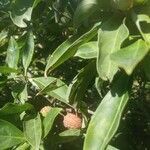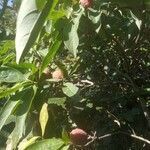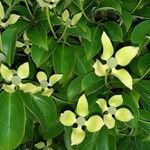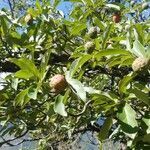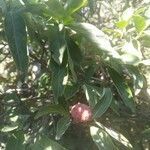Evergreen large shrub to small tree to c. 15 m high; young branches with short, stiff, appressed, medifixed hairs. Leaves opposite decussate: lamina oblong to elliptic, mostly 4–12 cm long, 1–4.5 cm wide, base cuneate to broadly cuneate, margin entire, apex acute to acuminate, both surfaces with minute appressed medifixed white hairs, upper surface mid-green, lower surface paler and whitish-or grey-green to glaucous; main veins elevated below, sometimes pinkish, domatia present; petiole (5–) 7–10 mm long. Inflorescences solitary, a dense cluster of many small flowers, hemispherical, c. 1–1.5 cm across; bracts usually 4 (sometimes 5), petal-like, ovate-obovate (often broadly so), rarely ± elliptic or orbicular, 2–5 (–6.5) cm long, 1.5–3.5 (–4.7) cm wide, coriaceous, pale yellow or cream, sometimes white or white tinged with yellow. Flowers very small, greenish yellow, sessile; sepals 4, obtuse, erect, ultimately caducous, calyx-tube cylindric, pubescent; petals 4, oblong, cuneate, c. 2 mm long, spreading, slightly keeled above; stamens 4, alternating with petals. Drupes coalesced into a succulent, globular, strawberry-like head 2.5–5 cm across, yellow to red, each drupe with a hard 1-seeded stone.
More
Trees or shrubs, evergreen, 3–15(–20) m tall. Bark brown or blackish gray; young branches grayish green, pubescent with white appressed trichomes; old branches grayish brown, nearly glabrous. Flower buds globose, exposed, subtended by four small green, linear-lanceolate bracts; leaf buds exposed. Leaf blade grayish green on both surfaces, narrowly elliptic or oblong-lanceolate, 5–12 × 2–3.5(–4) cm, thinly leathery to leathery, abaxially densely pubescent with thick white appressed trichomes, scabrous, axils of veins often pitted or rarely with a cluster of trichomes, veins 3 or 4, base cuneate to broadly cuneate, apex acuminate to shortly caudate. Cymes globose, ca. 1.2 cm in diam., 50–100-flowered; bracts white, obovate or broadly obovate, rarely orbicular, 3.5–6.2 × 1.5–5 cm. Calyx tube ca. 1.2 mm, hardly lobed to conspicuously 4-lobed; lobes rounded. Petals oblong, 3–4 mm. Styles cylindrical, ca. 1.5 mm, densely pubescent with white trichomes. Infructescences compressed or subglobose, 1.5–2.5 cm in diam., pubescent with small white trichomes, purple red at maturity; peduncle (1.5–) 4–5(–8) cm, stout. Fl. May–Jul, fr. Sep–Nov.
An evergreen tree or shrub. It can lose its leaves. It grows 3-15 m high. The bark is greyish brown. The leaves are opposite. They are 4-9 cm long by 1.2-3 cm wide. They are oval and leathery. They are pale underneath. The flowers are yellowish. Flowers are closely packed in heads. These are 1-1.5 cm across. The fruit join into a fleshy, strawberry-like head. These are 2.5-5 cm across. They are juicy but tasteless.
It is a temperate plant. It grows in evergreen and mixed forests between 1000-3200 m altitude in China. In Nepal is grows between 1700-2600 m altitude. In the Indian Himalayas it grows between 1,500-2,200 m above sea level. It is mostly on moist hillsides. It will grow on most soils and in most positions. It is resistant to frost but sensitive to drought. Hobart Botanical Gardens. It suits hardiness zones 8-9. Arboretum Tasmania.
More
Forests and shrubberies; at elevations up to 3,400 metres. Moist hillsides; at elevations from 1,700-2,600 metres. Deep shade in evergreen and mixed forests; at elevations from 1,000-3,200 metres.
Recorded growing in moist montane forest (including Eucalyptus tall open forest), remnant native Eucalyptus woodland on sandstone, disturbed areas and near roadsides.
Cultivated as an ornamental. The fruits are edible, eaten raw or cooked. The bark, branches and leaves are a source of tannin, which has been used medicinally (Fern 2019).
More
The ripe fruit is edible and sweet tasting. It is eaten raw. They are also brewed into alcohol. Caution: Alcohol is a cause of cancer. They are also made into preserves.
